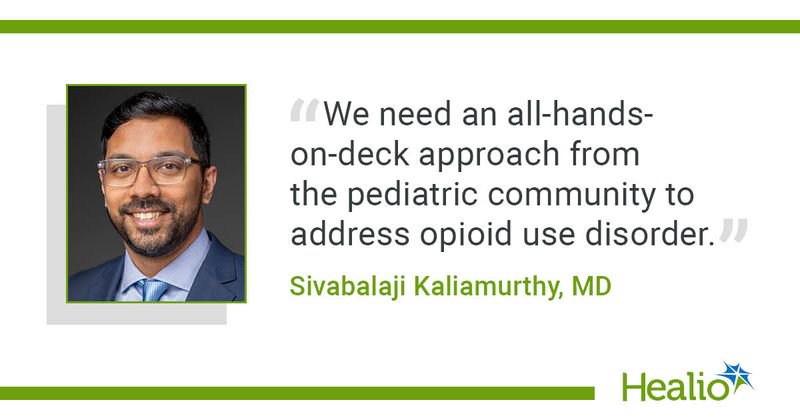Q&A: ‘No reason’ buprenorphine should not be offered in pediatric EDs
Key takeaways:
- Initiating buprenorphine for opioid use disorder is common in adults EDs but less is known about its use in pediatric EDs.
- The ED-based buprenorphine treatment of two teens demonstrated its feasibility.
A recently published case report summarized the successful initiation of buprenorphine treatment in two adolescents who presented to a pediatric ED with opioid withdrawal.
According to the authors of the report, although initiating buprenorphine for opioid use disorder (OUD) is common in adult EDs, less is known about its use in pediatric EDs. The authors said the two adolescent cases showed that starting buprenorphine in pediatric EDs can be an “important and timely” intervention for OUD.

Overdose deaths among high school-aged adolescents in the United States more than doubled between 2019 and 2020, driven by counterfeit pills containing illicit fentanyl, but less than half of pediatricians who responded to one survey said they felt prepared to counsel patients on OUD.
The new case report involved two patients — a 16-year-old boy and a 17-year-old girl — who were treated in an ED for OUD after using counterfeit pills that contained fentanyl. Both patients were prescribed a regimen of buprenorphine or naloxone in the ED before attending an outpatient addiction clinic.
Healio spoke with one of the authors of the report, Sivabalaji Kaliamurthy, MD, an addiction psychiatrist and director of the Addictions Program at Children’s National Hospital in Washington, D.C., to learn more.
Healio: What prompted you to examine this issue?
Kaliamurthy: There was an increasing number of adolescents presenting to the emergency room seeking out help with their fentanyl/opioid use disorder. Timely intervention is crucial in this population. There are no specific detoxification units in our region for patients younger than 18. There is a shortage of pediatric hospital beds, which makes inpatient admission difficult. Outpatient/ambulatory detoxification has its own challenges and is often unsuccessful.
The emergency room offers a supervised environment to initiate buprenorphine. Buprenorphine is commonly initiated in emergency rooms that serve adults; there is no reason this should not be offered in a pediatric emergency room.
Healio: Who were the patients and how were they treated?
Kaliamurthy: The two patients are minors, younger than 18, who presented to the pediatric emergency room for complaints related to withdrawal from fentanyl. They were both diagnosed with severe opioid use disorder. They were started on buprenorphine, an FDA-approved medication to treat opioid use disorder in patients 16 and older.
Starting buprenorphine is tricky due to its mechanism of action, which can worsen withdrawal symptoms if administered too close to the last use of fentanyl. The emergency room offered an opportunity to monitor their withdrawal symptoms and administer the medication at the right time.
Healio: What do these two cases demonstrate in terms of initiating buprenorphine in EDs?
Kaliamurthy: The two cases demonstrate that in certain cases — for example, patients younger than 18 with opioid use disorder and no other complications that would warrant inpatient admission — buprenorphine can be safely initiated in the emergency room.
Initiating buprenorphine may increase the chances of patients successfully transitioning to outpatient care and help keep them engaged in treatment.
Healio: Are there medication shortages or regulations that might get in the way of initiating buprenorphine in pediatric EDs?
Kaliamurthy: [There are] no concerns around medication shortages or regulations if a patient is 16 years of age or older. Some states prevent off-label use of this medication — for example, if the patient is younger than 16, even if they have severe opioid use disorder.
Other challenges to widespread use of this intervention in pediatrics include lack of provider comfort with this medication; [the fact that] many pediatric hospitals do not carry this medication on their formulary, which can make access difficult; [and] initiating this medication in the emergency room requires the hospital to have access to outpatient clinics that will be willing to continue this treatment upon discharge, and there aren’t too many outpatient providers or clinics that provide this treatment.
We need an all-hands-on-deck approach from the pediatric community to address opioid use disorder in children and adolescents. This requires the health care system to step up and fill the gaps across the spectrum: knowledge, access to medications, treatment facilities, insurance reimbursement, etc.
Reference:
Kumar P, et al. Pediatrics. 2024;doi:10.1542/peds.2024-066226.
For more information:
Kaliamurthy directed interested readers to childrensnational.org/get-care/departments/addictions-program for additional resources on the topic.

